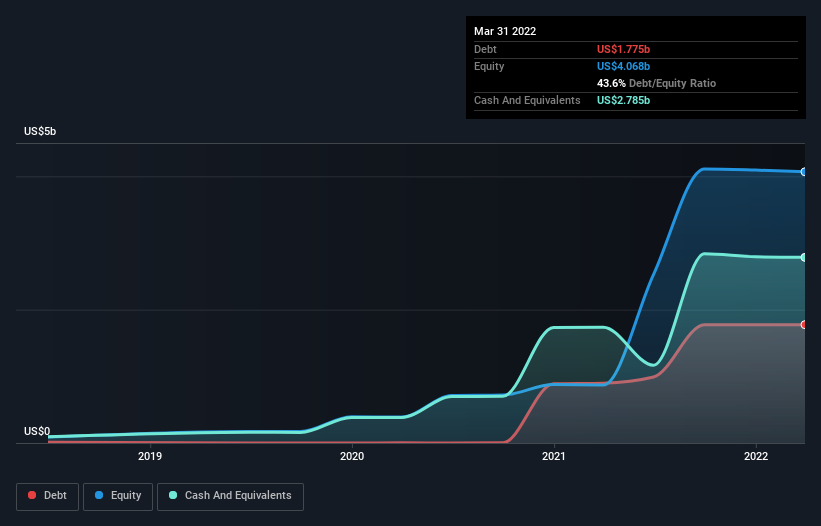The external fund manager backed by Berkshire Hathaway's Charlie Munger, Li Lu, makes no bones about it when he says 'The biggest investment risk is not the volatility of prices, but whether you will suffer a permanent loss of capital.' It's only natural to consider a company's balance sheet when you examine how risky it is, since debt is often involved when a business collapses. As with many other companies Bill.com Holdings, Inc. (NYSE:BILL) makes use of debt. But is this debt a concern to shareholders?
What Risk Does Debt Bring?
Debt and other liabilities become risky for a business when it cannot easily fulfill those obligations, either with free cash flow or by raising capital at an attractive price. If things get really bad, the lenders can take control of the business. However, a more frequent (but still costly) occurrence is where a company must issue shares at bargain-basement prices, permanently diluting shareholders, just to shore up its balance sheet. Having said that, the most common situation is where a company manages its debt reasonably well - and to its own advantage. The first step when considering a company's debt levels is to consider its cash and debt together.
What Is Bill.com Holdings's Debt?
As you can see below, at the end of March 2022, Bill.com Holdings had US$1.77b of debt, up from US$897.9m a year ago. Click the image for more detail. But on the other hand it also has US$2.78b in cash, leading to a US$1.01b net cash position.

A Look At Bill.com Holdings' Liabilities
The latest balance sheet data shows that Bill.com Holdings had liabilities of US$4.39b due within a year, and liabilities of US$723.7m falling due after that. On the other hand, it had cash of US$2.78b and US$276.1m worth of receivables due within a year. So its liabilities total US$2.05b more than the combination of its cash and short-term receivables.
Of course, Bill.com Holdings has a titanic market capitalization of US$13.2b, so these liabilities are probably manageable. But there are sufficient liabilities that we would certainly recommend shareholders continue to monitor the balance sheet, going forward. Despite its noteworthy liabilities, Bill.com Holdings boasts net cash, so it's fair to say it does not have a heavy debt load! There's no doubt that we learn most about debt from the balance sheet. But ultimately the future profitability of the business will decide if Bill.com Holdings can strengthen its balance sheet over time. So if you're focused on the future you can check out this free report showing analyst profit forecasts.
In the last year Bill.com Holdings wasn't profitable at an EBIT level, but managed to grow its revenue by 157%, to US$520m. So there's no doubt that shareholders are cheering for growth
So How Risky Is Bill.com Holdings?
Statistically speaking companies that lose money are riskier than those that make money. And we do note that Bill.com Holdings had an earnings before interest and tax (EBIT) loss, over the last year. And over the same period it saw negative free cash outflow of US$4.1m and booked a US$283m accounting loss. But the saving grace is the US$1.01b on the balance sheet. That means it could keep spending at its current rate for more than two years. The good news for shareholders is that Bill.com Holdings has dazzling revenue growth, so there's a very good chance it can boost its free cash flow in the years to come. While unprofitable companies can be risky, they can also grow hard and fast in those pre-profit years. When analysing debt levels, the balance sheet is the obvious place to start. However, not all investment risk resides within the balance sheet - far from it. Case in point: We've spotted 4 warning signs for Bill.com Holdings you should be aware of.
If, after all that, you're more interested in a fast growing company with a rock-solid balance sheet, then check out our list of net cash growth stocks without delay.
Have feedback on this article? Concerned about the content? Get in touch with us directly. Alternatively, email editorial-team (at) simplywallst.com.
This article by Simply Wall St is general in nature. We provide commentary based on historical data and analyst forecasts only using an unbiased methodology and our articles are not intended to be financial advice. It does not constitute a recommendation to buy or sell any stock, and does not take account of your objectives, or your financial situation. We aim to bring you long-term focused analysis driven by fundamental data. Note that our analysis may not factor in the latest price-sensitive company announcements or qualitative material. Simply Wall St has no position in any stocks mentioned.
The views and opinions expressed herein are the views and opinions of the author and do not necessarily reflect those of Nasdaq, Inc.


